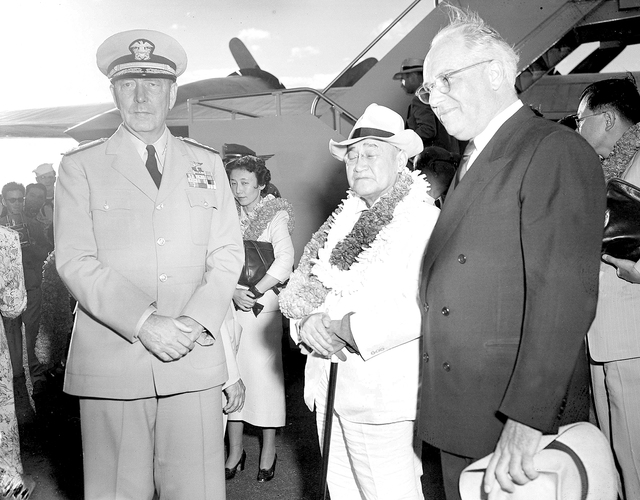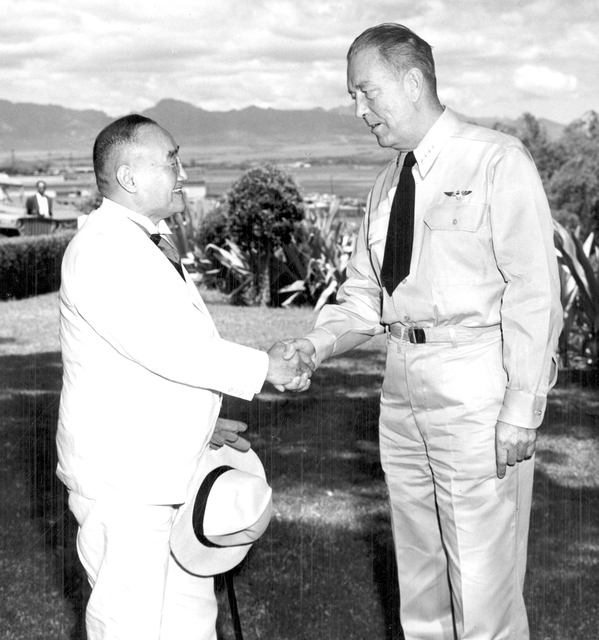TOKYO — Japanese Prime Minister Shinzo Abe, who will visit Pearl Harbor today with President Barack Obama, wasn’t even born when Japan’s former leader Shigeru Yoshida visited there just six years after the country’s World War II surrender, by himself and feeling awkward.
Yoshida is best remembered for signing the San Francisco peace treaty with the U.S. and others in 1951, allowing Japan back into international society after its war defeat. His Pearl Harbor visit, which he made on his way home from San Francisco, largely was eclipsed by the historic treaty.
Archival writings and photos unearthed by the Associated Press reconstruct Yoshida’s visit, from his aim to win U.S. trust to how he was put at ease by the U.S. Navy commander’s dog.
Yoshida arrived Sept. 12, 1951, at Pearl Harbor, shortly after requesting a courtesy visit to the office of Adm. Arthur W.R. Radford, commander of the U.S. Pacific fleet. The office overlooked Pearl Harbor, offering a direct view of the site of the Japanese attack of Dec. 7, 1941.
Radford recalled that he thought Yoshida might feel uncomfortable because of his office’s location.
“I could almost see the wreck of Arizona” out of the window, he wrote in his memoir, “From Pearl Harbor to Vietnam,” referring to a battleship that sank in the attack.
Yoshida, westernized and fluent in English, showed up in a white suit, wearing his trademark brimmed hat and carrying a cane, apparently looking a bit stiff.
Then, Radford’s dog broke the ice.
His little Scottish terrier, which was stretched out in front of Radford’s desk, walked slowly to Yoshida to be patted, while sniffing around his shoes and ankles.
“That started a dog conversation that took most of the visit,” Radford wrote.
Yoshida was a dog fancier, and bought terrier puppies just before leaving San Francisco, his grandson, Taro Aso, currently Japan’s finance minister, said. Yoshida named the pair “San” and “Fran” after his successful trip.
Years later, Yoshida told Radford’s wife how he was embarrassed when he walked into the office after seeing Pearl Harbor, and how happy he was the dog was able to settle him down.
A Navy archival photo obtained by the AP shows the two men shaking hands, with a smiling Yoshida looking up at the much taller Radford. Yoshida spent about 20 minutes at the office, according to an AP story from Sept. 13, 1951.
Yoshida’s visit to Pearl Harbor actually was during his second Hawaii stopover, having also stopped here on his way to San Francisco.
But he was more relaxed the second time after completing the important mission in San Francisco, where he also signed the original Japan-U.S. security pact.
On his way to California, Yoshida landed Aug. 31, 1951, in Honolulu, when Japan was still technically an enemy.
During that visit, he laid flowers for the war dead at Honolulu’s National Memorial Cemetery of the Pacific, better known as Punchbowl. Three other Japanese prime ministers since have followed suit.
Yoshida’s daughter, Kazuko Aso, who was traveling with him, recalled that security was extremely tight in Hawaii on his first stopover, before the peace treaty was signed, and that Yoshida, who stayed on the top floor of the Royal Hawaiian Hotel, was instructed not to leave the hotel for safety reasons.
“But that old man insisted he wanted to go out … to pay tribute to the war dead,” Aso said in an interview published in the Bungei Shunju monthly magazine weeks after the trip.
She said the Japanese delegation unexpectedly received a warm welcome. Photos in the Japanese newspaper Mainichi showed Yoshida’s face nearly buried in lei because he received so many of them at the airport.
During the Sept. 12, 1951, reception attended by U.S. military and Hawaiian officials, Yoshida sought further U.S. economic assistance and cooperation to reconstruct his war-devastated country and pledged to never use aggression.
Two days later, the Honolulu Star-Bulletin welcomed his speech as “a notably frank admission of Japan’s war guilt and a pledge that Japan will do everything possible to repair the enormous damage done by her armies, navy and air force.”
Associated Press writer Audrey McAvoy in Honolulu contributed to this report.









